
Charlie in my heatbox, recovering from surgery. Yes that’s some shredded newspaper lining in his claws…
If there is one thing that my recent experiences with my galah Charlie has taught me – it’s the importance of having some sort of hospital set up on standby in case your bird ever becomes critically ill. Even if you are lucky enough to have access to an out of hours vet who can hospitalize a sick bird, having a hospital setup can be extremely useful to help your bird continue to recover once it is well enough to come home.
There are four main things that I think are essential to keep in mind when putting together a hospital cage setup:
1) Keep it Simple.
The whole point of a hospital cage is to simplify things for a bird that currently can’t cope with “normal”.
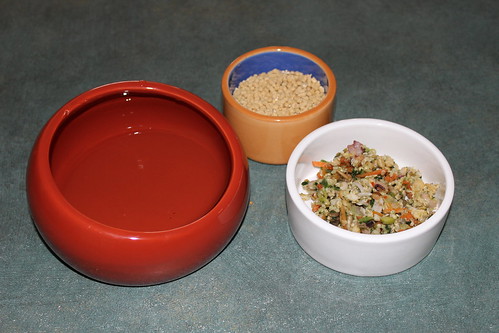
Keeping it simple: I keep a collection of shallow dishes, so the bird doesn’t have to climb to eat or drink.
This usually requires a smaller cage or enclosure than what your bird is accustomed to. I find collapsible dog crates or travel cages to be quite handy for this, but I also have a heatbox (reptile enclosure) on hand for more extreme situations.
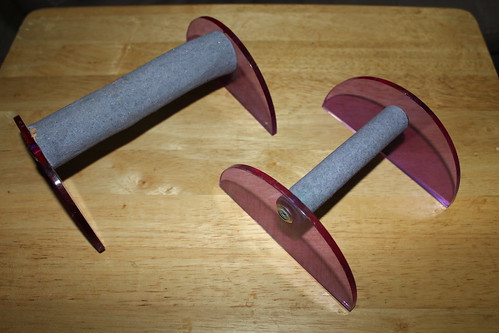
I use a range of t-perches. These are store bought. I re-use the perspex sides, screwing in natural perches. The point is to keep perches low, so the bird can’t fall far.
The reason that smaller than normal is better, is because the aim is to make everything easier for the bird. You don’t want them to have to expend a lot of energy to get to food and water, so in theory smaller should bring everything closer together. I keep a range of shallow dishes for use in my hospital setup. I also make my own t-stands or stable low perches. If they fall off a perch, you don’t want them to fall more than an inch or two. If a bird is going to be on the one perch for a long time, I’ll wrap it with vet wrap to make it softer, preventing foot injuries.
2) Keep it Clean
Meticulous hygiene is something I strive for at the best of times but it is more than essential for a sick bird.
A sick bird is at high risk of contracting some sort of secondary infection, so exposure to droppings, old food or any sort of bacteria really can increase that risk. Not to mention that a lot of illnesses are carried within a sick bird’s droppings, so you should be disposing of any soiled cage linings very carefully and regularly. (I use a water misting spray, to spray any newspaper before carefully rolling it, in order to prevent any contaminates/dust from becoming airborne during cleaning.)

When Charlie was getting better, he was still too weak to bathe but he appreciated a dish of damp grass (gone to seed) that he could rub himself with. It also gave him something to do (that didn’t involve removing his stitches). Putting it in a dish made it easy to remove.
Think about how to set up your cage to allow for more frequent than normal removal of any cage linings. This will also help you monitor any changes in droppings as they occur.
Consider using a vet-grade bird-safe disinfectant when cleaning. Your vet should be able to sell you this sort of disinfectant. A good one is able to kill viruses and bacteria. I use F10 (which can also be found on ebay).
3) Keep The Setup Warm
Sick birds will struggle to maintain their own temperature. Providing an external heat source in this situation is often life-saving.
A bird’s resting body temperature (depending on species) usually sits between 38.5C/101.3F and 40C/104F. Their active temperature (depending on species) can usually increase up to 42C/107.6F.
In order to help a bird maintain their temperature, ideally a hospital set up should be maintained at around 25C or 77F.
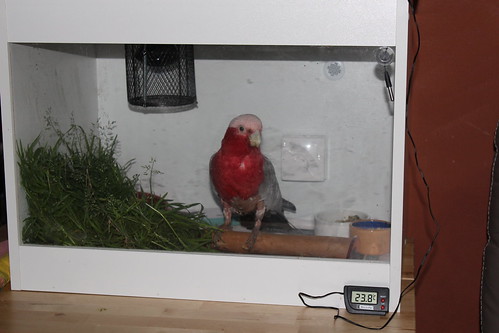
The thermostat switches the heat globe on and off. The temperature drops to around 23C when off but goes up to 26C when on, which is roughly the range I want. Note the digital thermometer is prominent and monitoring the temperature. I don’t simply trust the thermostat (in case the bird recovers enough to start turning the thermostat to a different temperature!!!!)
There are a number of ways of doing this. Most of the easiest methods seem to involve reptile equipment.
This might be a bit extreme/expensive for the average bird person, but I keep a reptile enclosure/hot box on standby. I do this mainly because I have a really old galah with a heart condition. (He’s 65 this year.) He has his bad days and I can honestly say, the hotbox has saved his life more than once.

My elderly galah Cocky Boy needs a heat lamp available 24/7. He has a special “disabled” setup for everyday use but a hospital setup is essential for a bird of his age as he does occasionally need it.
The obvious advantage of using something like a hotbox is that it is designed to hold a constant temperature, despite having vents that still allow airflow. The one that I use has a thermostat that switches a heat generating light globe on and off. The globe stays on long enough to maintain the temperature but switches off to prevent overheating.
An alternative is simply to use a smaller cage or a travel cage and partially cover it to help trap heat. If you do this, covering the cage is not enough on its own you need to use an external heat lamp in order to provide the heat.
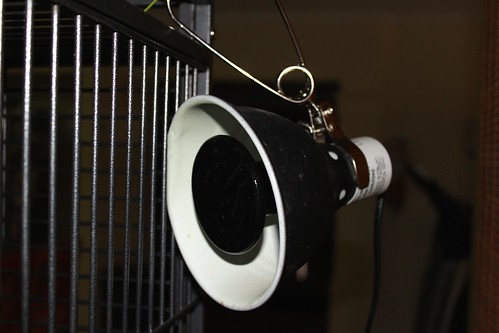
The “Exo Terra Ceramic Glow Lamp” with a 60W ceramic globe. This is the external heat lamp that I use. The white part glows slightly in the dark. Handy to help prevent you accidentally brushing it and burning yourself in the dark!
If you’re going to use something like this it is important to know what sort of globe the heatbox thermostat is calibrated to or temperature that the lamp is designed for. My box (like most) is designed to use a 60W red globe. It maintains the exact temperature that the thermostat is set to, if I use that globe. That’s great, except I don’t like using that sort of globe.
Red heat globes are actually the type of globe that many avian vets and bird specialists use. Even so, I can’t in good conscience recommend them myself. I don’t like them for a couple of reasons.

These are the globes I’m talking about and the black mesh thing is a cage I screw over the globe in the beatbox in order to prevent a bird from burning itself.
Firstly, I find the light disturbs the birds at night, whereas the ceramic globes (that don’t emit light) don’t. I’ve learned to take note when a bird is distressed by something and I’ve seen more than one bird disturbed by a red globe. Also after you’ve seen a glass heat globe shatter/explode, you’re unlikely to ever want to put one above your bird. You can buy shatterproof globes but their shatterproof coating is usually made of Teflon. (Teflon and birds don’t mix well.)
I’m also not confident in saying that red globes are 100% safe for long-term use. I’ve read a mixture of studies that say red globes are perfectly safe and preferred; others say they can cause cataracts/damage eyesight. As a general rule, when studies seem to produce such conflicting results I tend to assume it’s something we’ll know more about in 5 years time and so I’m wary about recommending them until that time.
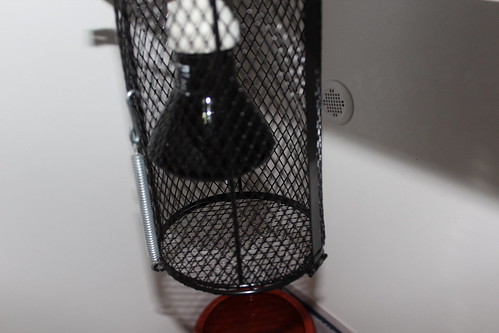
This is how the black powder coated cage fits over the globe. Unlike the globe, it doesn’t get too hot to touch.
I use ceramic globes. On the bright side, they’re not known for shattering but they also have some significant disadvantages. They don’t emit light, so you can’t tell if they’re on by looking at them and you can get a really nasty burn if you touch a hot one. They also tend to emit more heat than the average glass heat globe, which means you’ve got to be careful what you put them in – you might need a lower wattage to be safe. I use a 50W in my heat box, but a 60W in my heat lamp (which is designed for an 80W red globe). I actually check the temperature with a reptile enclosure thermometer. Even using a 50W globe in the heatbox, I find the temperature sits at approximately 5C above what the thermostat is set to. It does pay to test these things before you need to put a live animal in there.
4) Make It A Stress Free Environment.
Keep your hospital setup away from the television, noisy children and other pets. A sick bird needs a quiet calm environment to rest. Not a space where someone keeps prodding it to see if it’s dead yet?
It’s very easy to overlook this when you’re catering to your desire to have the bird somewhere near you, where you can keep a close eye on it. Us humans tend to be noisy creatures, so close by might not be the best idea!
Finally – if you’re following my galah Charlie’s story. I’m pleased to say he has recovered from his surgery and is back in his own cage. His prognosis isn’t great. The diagnosis has been confirmed as very advanced fatty liver disease. For the moment he is stable and responding very well to medication but his condition should gradually advance as his biopsy results show that it has already advanced too far to be reversed. So it’s one day at a time, doing everything that can be done to help such a sick liver. While he has a good quality of life, there is still hope for him.
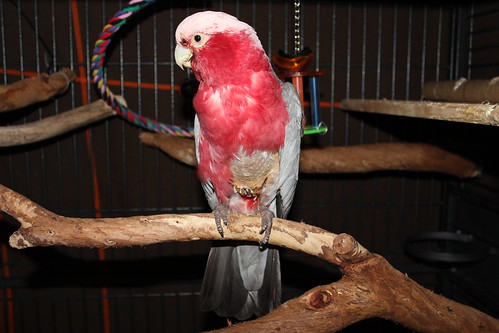
Having noticed that Charlie had mastered the art of changing the thermostat settings by himself, I decided Charlie was ready to return to his own cage, where he has an external heat lamp that he can sit next to when he feels the need.
Mel Vincent works as an animal rehabilitator out of Australia.



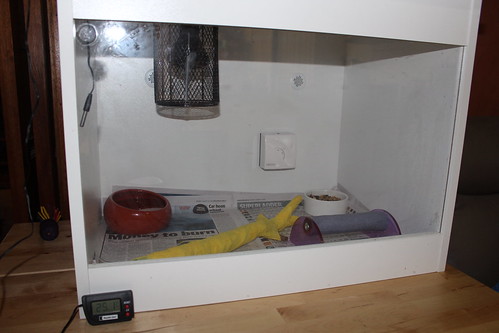
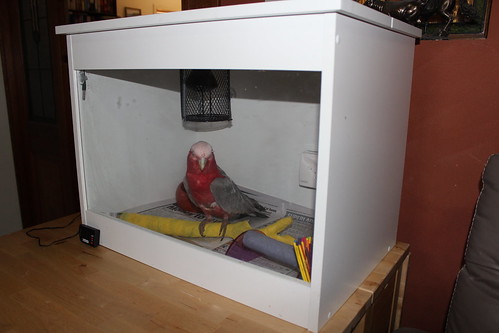
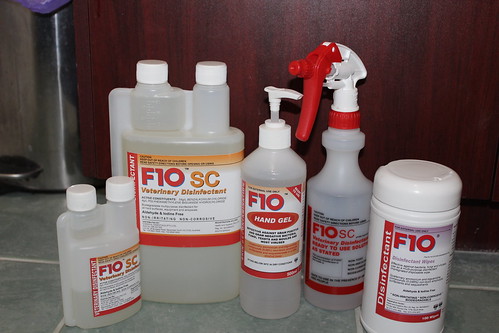
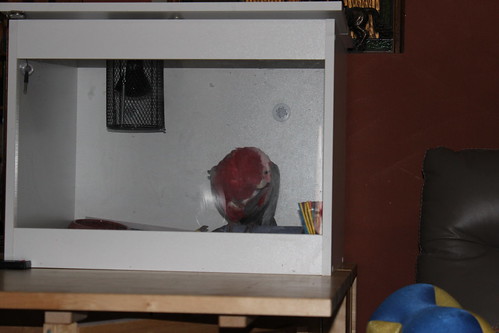
9 comments
I need more info on the ceramic heat bulb what do you put it in (socket) and the black powder coated cage it goes in. Are there any type of switch with a thermostat on it already to turn on and off? I have a very sick yellow nape w/heart disease, arthritis, and now a yeast infection, he’s 50++
The difficulty with a heat mat is that it only really provides effective heat if the animal is in contact with it. So the bird actually has to sit on it, to get any benefit and any covering is going to reduce the amount of heat that the bird feels anyway. Unlike a lamp, a mat won’t change the environment’s temperature significantly – it only gives you a basking point. So if the animal moves away from it – there is no effect. A globe however reaches further. i.e. if the animal is close to the globe, it’s sitting at the warmest point but it can move away if its getting too hot but still receive benefit from it. That said, I do use heat mats too but I use them for a different purpose. I have one that plugs in to the cigarette lighter of my car. I find it very useful for transporting sick animals (not just birds) to the vet. In this case the heat mat fits neatly into my travel carrier and the animal sits on it for the duration of the trip. The idea is the animal is too sick to maintain its temperature, so the heat mat stops it from dropping too drastically when you’re out of a controlled environment. If you don’t have a plug-in one a portable heat pad can work for this too.
Would it be possible to use a heat mat instead of the lamp ? Obviously it would have to be covered so the bird can’t chew at it. I have a large reptile glass tank which has heat lamps & I also have a heat mat which would be the best option as I have a variety of birds/parrots & after reading your post I now want a permanent set up for when the need arises. Thank you and all the best for Charlie.
I do use an alcohol free milk thistle extract as prescribed by my vet. In Charlie’s case (and my other galah Morgy who has a similar liver) it’s not enough on its own though. They do need specialised compounded liver medications on a daily basis. Have a look at this blogpost that I wrote last year: http://www.birdtricks.com/blog/milk-thistle-and-miracle-cures-for-parrot-liver-problems/
Great info thank you. Could you please tell me where you purchased the low perch stands, I’ve been looking everywhere and cannot find any?
I’ll say this about that. How well do you think you could sleep with a big ass bright light shining in your face all the time? Thats how the military gets people to talk so they can sleep, big ass bright lights on all the time. Not being a doctor my self, I know that anybody thats sick or hurt needs sleep and a lot. The heat lamp. One can just get a colored flood light and a light socket will do. 100 watt is what I use and it goes under the cage. The last I heard, heat rises right? So put the cage on a stand, drill holes in the bottom then cover the floor with paper. I use a 100 flood for Cookies big cage but for a small cage just normal bulb 60 watt should work, heat rises. All vets know this and its in all the books. Well, some books. This how I heat Cookies cage in the non summer months here in Miami. Even the ac causes her to sneeze and get a cold. I’ve been doing this for 31 years for my little girl. So you don’t even have to buy another cage, turn the cage you have into a hospital cage. Unless the vet says hospital cage because they don’t want the parrot to move around so much.
I got them from a shop called “Stinkys Pet Supplies” located in Rosebud, Victoria, Australia. (Great store name, isn’t it?) It was over a year ago and I haven’t been back since, so I’m not sure if they still stock them? It’s very easy to make something like this though. If you can’t get perspex, I’ve used used raw untreated blocks of pine before and screwed a natural branch between two small blocks. Just make sure your screws are bird-safe metal (stainless steel is best).
Great, informative article. I love your posts, I usually get the giggles from a lot of your posts. So sad for Charlie, sending healing thoughts your way.
What do you think about administering Milk Thistle extract (liquid, doesn’t have alcohol) for liver detox and support. Vitacost carries it.
Leave a comment